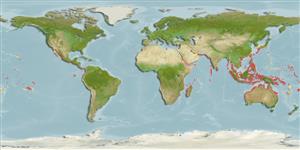Environment: milieu / climate zone / depth range / distribution range
Écologie
marin; eau douce; saumâtre benthopélagique; amphidrome (Ref. 51243); profondeur 0 - 3 m (Ref. 86942). Tropical; 22°C - 28°C (Ref. 13614)
Indo-Pacific: south to East London, South Africa (Ref. 2798). Western Central Pacific: Guam (Ref. 35720). Often confused with the more common Glossogobius giuris.
Taille / Poids / Âge
Maturity: Lm ? range ? - ? cm
Max length : 19.8 cm TL mâle / non sexé; (Ref. 108711)
Description synthétique
Clés d'identification | Morphologie | Morphométrie
Épines dorsales (Total) : 7; Rayons mous dorsaux (Total) : 9; Épines anales: 1; Rayons mous anaux: 8. Body dark brown to black, with longitudinal rows of small black spot; 2-3 saddles on back and side; black 1st dorsal fin; dark crossbands on pelvic fins (Ref. 2798).
Inhabits intertidal areas, estuaries, lagoons and coastal rivers. Common in mangroves (Ref. 4343, 44894). Occasionally penetrates the lower reaches of freshwater streams (Ref. 44894).
Life cycle and mating behavior
Maturité | Reproduction | Frai | Œufs | Fécondité | Larves
Maugé, L.A., 1986. Gobiidae. p. 358-388. In J. Daget, J.-P. Gosse and D.F.E. Thys van den Audenaerde (eds.) Check-list of the freshwater fishes of Africa (CLOFFA). ISNB, Brussels; MRAC, Tervuren; and ORSTOM, Paris. Vol. 2. (Ref. 4343)
Statut dans la liste rouge de l'IUCN (Ref. 130435: Version 2024-2)
Menace pour l'homme
Harmless
Utilisations par l'homme
Pêcheries: sans intérêt
Outils
Articles particuliers
Télécharger en XML
Sources Internet
Estimates based on models
Preferred temperature (Ref.
123201): 24.2 - 29.3, mean 28.4 °C (based on 2860 cells).
Phylogenetic diversity index (Ref.
82804): PD
50 = 0.6250 [Uniqueness, from 0.5 = low to 2.0 = high].
Bayesian length-weight: a=0.01047 (0.00632 - 0.01736), b=3.03 (2.89 - 3.17), in cm total length, based on LWR estimates for this species & (Sub)family-body (Ref.
93245).
Niveau trophique (Ref.
69278): 3.5 ±0.4 se; based on size and trophs of closest relatives
Résilience (Ref.
120179): Milieu, temps minimum de doublement de population : 1,4 à 4,4 années (Preliminary K or Fecundity.).
Fishing Vulnerability (Ref.
59153): Low vulnerability (10 of 100).
